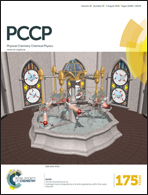The ionic transport mechanism and coupling between the ion conduction and segmental relaxation processes of PEO20-LiCF3SO3 based ion conducting polymer clay composites†
Abstract
A series of ion conducting polymer–clay composites has been prepared using a solution casting technique. Relaxation dynamics and the ionic transport mechanism are systematically studied employing broadband dielectric spectroscopy over a wide frequency and temperature range. Among different phenomenological and theoretical models for ion conduction in disordered ionic conductors, conductivity isotherm spectra are analysed using the modified Almond–West and random free energy barrier model. Conductivity scaling suggests that the ionic transport mechanism is independent of temperature, and a similar inference is also obtained using scaled electrical modulus spectra. DC conductivity along with conductivity and segmental relaxation time following the Vogel–Tammann–Fulcher relationship suggests coupling between the ionic transport and segmental relaxation processes. Electrical modulus and dielectric formalism are used to understand the conductivity and segmental relaxation processes, respectively. The presence of first and second universality in the ionic transport mechanism is discussed using the real part of conductivity spectra and dielectric loss spectra. The crossover between the first and second universality is explained using the Kramer-Krönig approach. The ion diffusion coefficient is investigated using Ratner's classical approach in combination with the modified Stokes–Einstein relationship to correlate the coupled nature of the ion conduction mechanism and polymer segmental motion.


 Please wait while we load your content...
Please wait while we load your content...